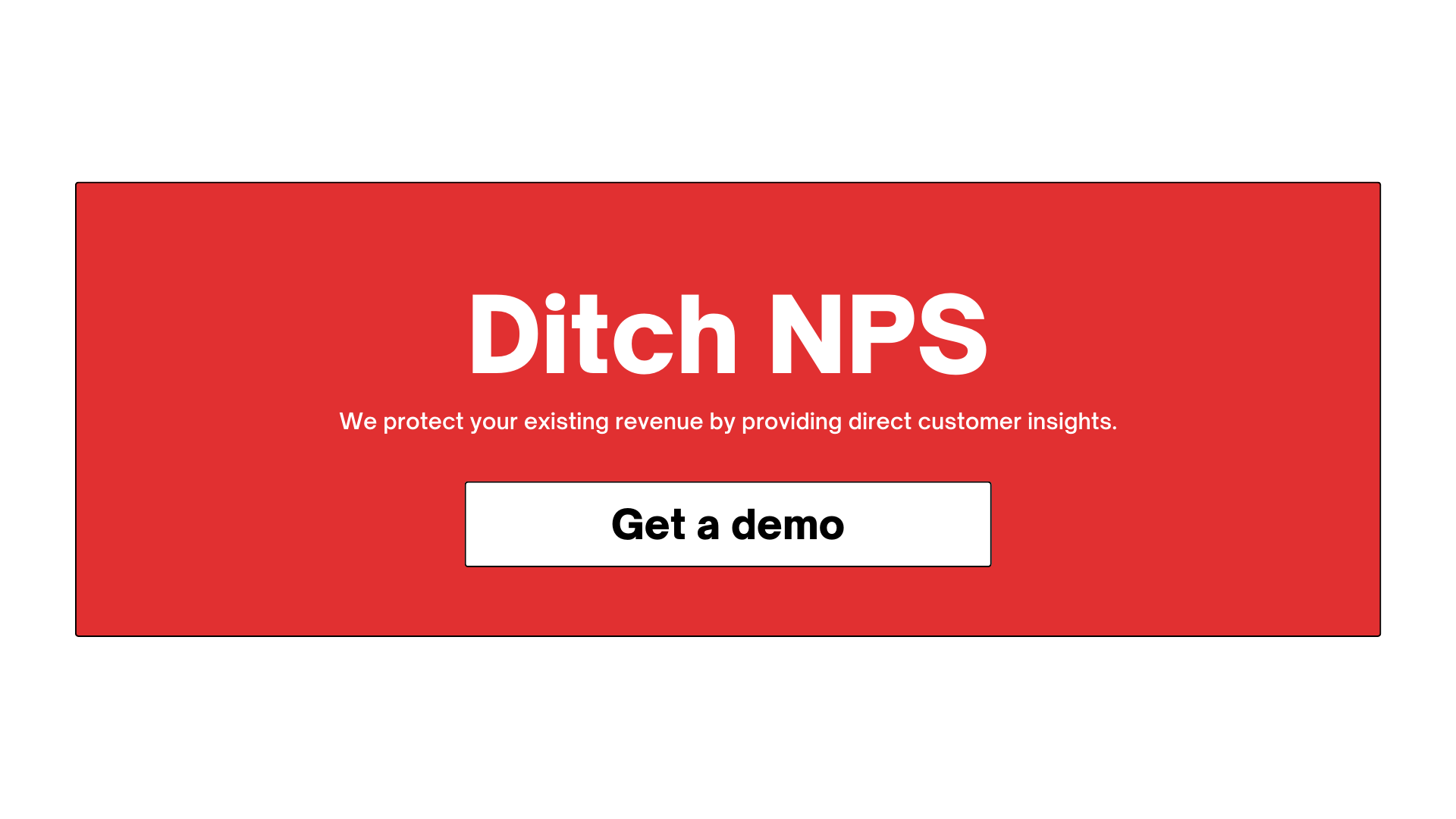Unlike Product or Engineering teams which require deep technical expertise, Customer Success can access broadly available core skill sets: relationship building, communication, organization, resilience. And these skills are abundant across a diverse population of potential hires.
But you can scroll through LinkedIn profiles, scan conference talks, or visit any CS awards list and see that we’re not meeting that opportunity. Customer Success, especially at the leadership level, is predominantly White.
This article wasn’t written to highlight a problem, though, it was written in partnership with the CS community to share tactics that will result in better hiring, retaining, and promoting Black team members.
Before we dive in—a special thank you to everyone who contributed to this article through interviews, ideas, and feedback: Mike Lee, Cairo Amani, Shadavia Jones, Kash Young, Charles Coaxum, Ja’Rod Morris, Valerie Jones-Harvey, Keishla Ceaser-Jones, Bliss Billingsley, Katrina Coakley, Anthony Edwards, Vance Gleton, Queen Joseph, Marco Carrubba, Kalina Bryant, and Jenna Karamanos.
First, some vocabulary
Important terms:
- Black - most people we interviewed preferred Black to describe the community because it’s the most inclusive term. It includes African Americans, Africans, Haitians, Cubans, South Americans. It’s also the term we’ll use in this piece.
- People of color - while the use of this term was also safe for most people, some people felt like it was too broad because it includes anyone that isn’t White. Those people preferred a term that more specifically addressed the needs of (and biases against) the Black community.
- African American - some people said they’d prefer African American because it honors their ancestry and also highlights the injustices their community has faced in the past.
Rule of thumb:
If you’re unsure of what someone identifies as, ask them!
Actions CS leaders can take to hire, retain, and promote Black employees
At a very high level, there are three areas companies can focus on:
- Creating an inclusive environment for your employees, which can lead to increased retention
- Recruiting and hiring more Black employees
- Developing and promoting Black employees into leadership positions
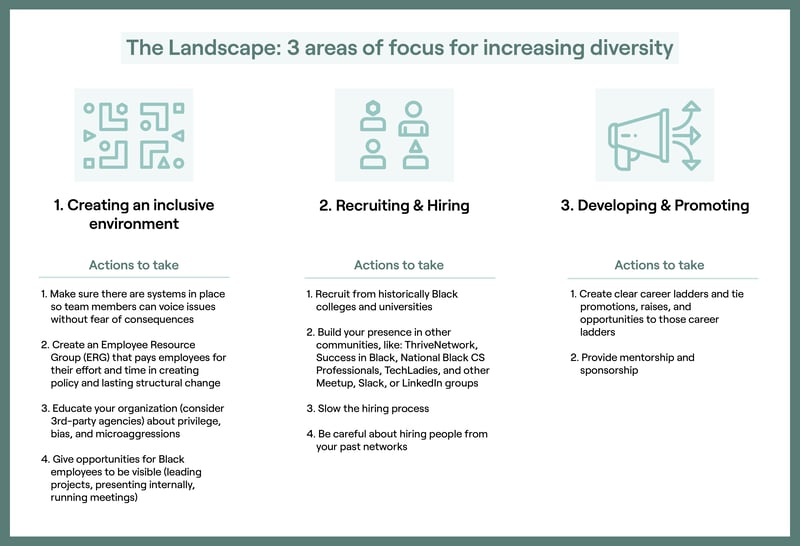
Most teams think they should start with #2 (hiring), but the reality is that creating an inclusive environment will help you hire more people from underrepresented backgrounds. Consider starting with your existing employees first.
#1: Create an inclusive environment
For the past several years, DEI has been a hot topic. But the focus is too often on “how to get more people in the door” — with less attention paid to what companies can do to include people after they’re hired.
“You don’t have diversity if you don’t have inclusion.”
Anthony Edwards, VP of Customer Success at TiLT
Our interviews identified a few of the best ways that companies can create an inclusive environment. But first, many folks noted that “inclusive” can be a nebulous word, and can only measure the inclusiveness of your workplace by asking employees what they think. There are plenty of good resources on this topic (see Culture Amp’s Inclusion Survey and HBR’s article on How to Measure Inclusiveness for example). Starting with an understanding of your employee’s perceptions will help you decide which of the initiatives below make the most sense for your team.
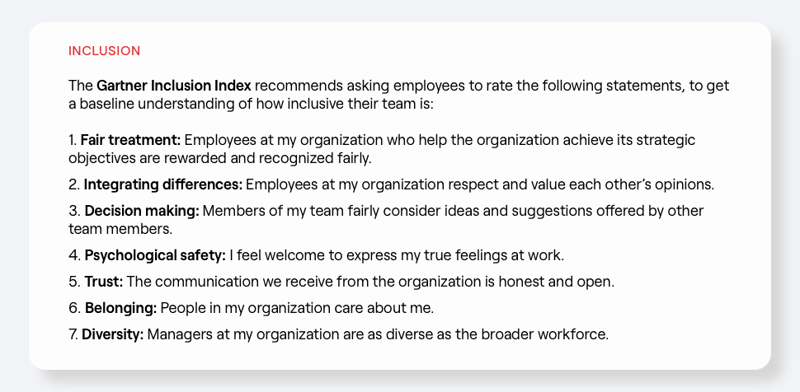
From HBR's article on Measuring Inclusion in the Workplace
“Non-white people don’t assume the grass is greener at a different company. They do a lot more asking around about whether or not people feel good about themselves and feel safe at work.”
Shadavia Jones, Manager - Customer Success Team at HubSpot
Here are some of the actions CS leaders can take to create an inclusive environment for immediate and longer-term change:
1. Make sure there are systems or resources in place so team members feel they can voice issues without fear of consequences.
For people at your company who don’t have a manager who looks like them: who do they go to to talk about their experiences with that manager? Be sure there are systems in place that allow team members to feel safe, heard, and know that something will be done when they talk about hard topics like microaggressions in the workplace. (There are tools available that help facilitate anonymous feedback and action from leadership—All Voices is an example.)
“Creating a sense of belonging at work is the outcome of three mutually reinforcing attributes. Workers should feel comfortable at work, including being treated fairly and respected by their colleagues. They should feel connected to the people they work with and the teams they are part of. And they should feel that they contribute to meaningful work outcomes.”
Deloitte Insights, Belonging
2. Sponsor an Employee Resource Group
Employee Resource Groups (ERGs) — groups that give employees safe spaces to bring their whole selves to the table and help in personal or career development — help bring people together to share their experiences, create connections, and together they often work to tackle company-wide challenges.
Leaders can support these groups in two notable ways: helping ERGs get the senior leadership commitment they need (if they don’t already have it), and advocating for group members to be paid for their time and effort in affecting company policy and creating change. (LinkedIn recently shifted to this model; Axios wrote about their model here which others can borrow from.) Leaders can also advocate for wider participation with the group.
ERGs tend to be employee-lead, but CS leaders can help to:
- Encourage their team members to start an ERG with resources on how to get started, and by connecting them to people in other companies who lead ERGs, and
- Help get executive buy-in (and ideally sponsorship) for the ERG.
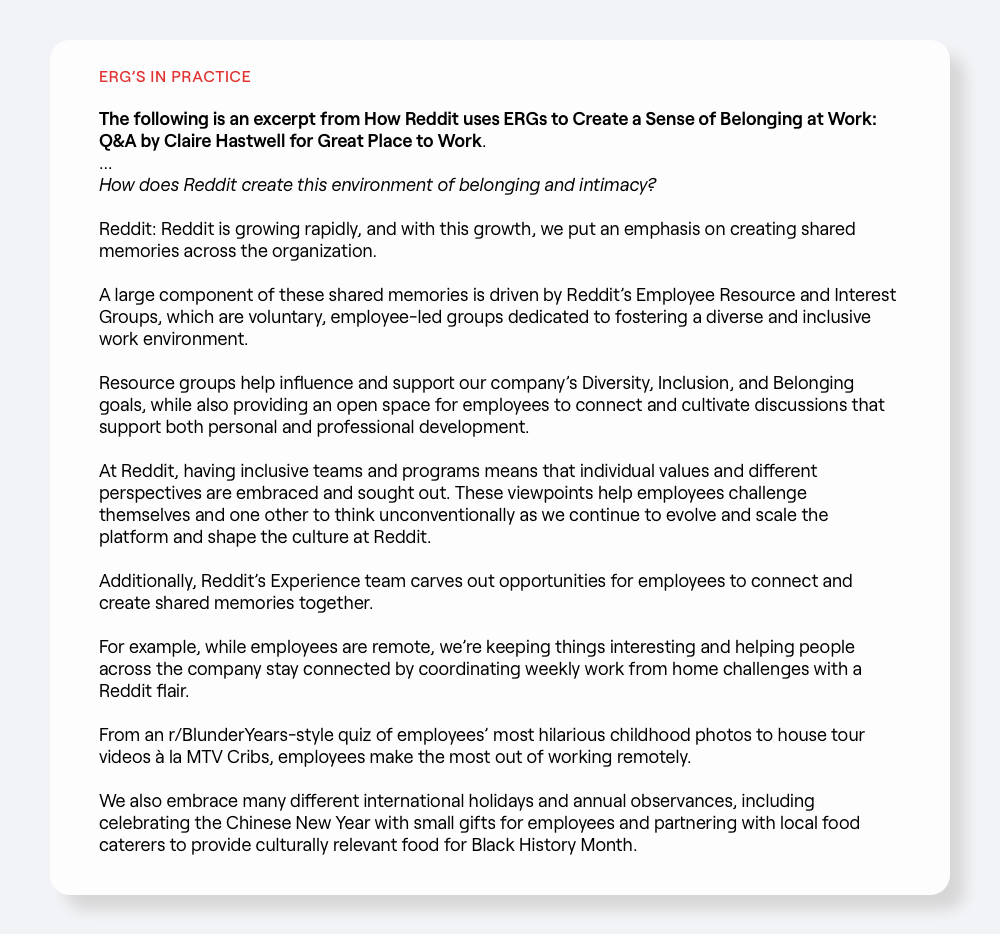
From How Reddit Uses ERGs to Create a Sense of Belonging at Work
3. Educate your organization
Companies need to educate their employees at all levels—leadership included—about:
- Becoming aware of privilege, and how to use privilege for good
- Understanding bias and how it shows up
- What microaggressions are and how to address them
- The value of building a diverse network and how people can do that
Hiring third-party agencies for this type of education will help make sure you’re hitting the right points. And to take it a step further, look to hire agency owners from underrepresented backgrounds.
This education is not one-and-done of course—regular training will serve as helpful reminders to self-reflect, look out for bias, and find ways to use privilege for good.
Note: One resource we heard was especially helpful was this training: But I’m Not a Racist… Right? At the company where this was used, everyone took the quiz.
“We should be challenging White leadership to be aware when they are in spaces that lack diversity to think about how they can impact those from a proactive perspective. And if they can't change the make-up of the room, how do they put processes in place to break the cycles and practices of "doing it the ways you've always done?" How do White people in all White spaces put a reflective lens on their own thinking and decision-making for the good of the business and inclusivity? How can leaders use advisory panels or reverse-mentoring as a way to get more diverse points of view in decision-making?”
Keishla Ceaser-Jones, Director of Partner Success & DEIB Leader
4. Create opportunities for Black employees to be visible
Sometimes companies do a lot of work to get candidates in the door — but then those people aren’t “visible” within the organization. They’re not given the opportunity to take the lead on projects or give presentations. Managers at any level can look out for this and help hand off big projects, training, or speaking opportunities (even at the team level).
“You don’t want it to be a token gesture, like ‘Go present for me at Gainsight’ so we can show others who is representing our company… But I do think there are a lot of opportunities for companies to have people of color present internally and push them to the forefront so it becomes common to see people of color leading and presenting.”
Charles Coaxum, VP of CX at Kenna Security (recently acquired by Cisco, 7/2021)
#2: Recruiting and hiring more Black employees
Recruiting and hiring more Black employees takes a deliberate effort:
- We need to promote Customer Success as an option for those just breaking into tech,
- Companies need to build their presence in networks and communities to find candidates, and
- Companies must shift their mindset from having broad diversity goals; if you're using terms like “BIPOC” and not being transparent about the breakdown of those groups, you risk meeting your goals by hiring one group (in many companies, Asian and Indian employees) and missing the others.
First: there’s a lot of research about having an unbiased interviewing process: removing names and locations from candidates in the screening process, reviewing job descriptions, doing a “blind” challenge early on.
Here are some other tips on improving your recruiting and hiring process to hire more Black employees:
1. Consider historically Black colleges and universities
Companies doing DEI initiatives usually think about recruiting from historically Black colleges and universities (HBCUs) as an early step. Two challenges to consider:
- Customer Success is a relatively new field so it’s not a known option for most college grads, and
- Companies usually send the DEI or HR person to job fairs.
Instead, try sending a CSM or a CS manager from your team to job fairs. Talk about Customer Success and the skills people can have and learn to be successful in a CS role.
Also, some companies recruit from HBCUs but don’t consider degrees from HBCUs and other backgrounds when making hiring decisions.
Note that many Black students attend PWIs (predominantly White institutions). Look into whether your company is finding those students when recruiting there.
2. Build your presence in other communities
CS leaders can get creative here: there are communities on Meetup, Slack, LinkedIn, Facebook, and more that are great places to find candidates for CS roles. Here are some communities that have been shared with us:
- National Black Customer Success Professionals
- ThriveNetwork
- Success in Black
- TechLadies
- National Black MBA Association
- Blacks in Technology
- BYP Network
- STEMettes
- UK Black Tech
- Sifted’s list
- Hiring from career programs like SuccessCOACHING
- And there are many location-based meetups, LinkedIn groups, and Facebook groups
Building your presence can mean giving presentations at these groups, participating in conversation, and partnering with the groups to promote career opportunities at your company.
It’s worth mentioning here the importance of hiring panels to consider Black professionals from other customer-facing backgrounds and industries outside of tech. For example, someone with retail experience would be great at Customer Success. This is a significant barrier for Black professionals to gain entry into CS; often, companies are looking for experience and recycle the same talent in the industry, which doesn't help recruit more Black professionals.
3. Slow the hiring process
Hiring cycles move fast: a business need comes up, there’s urgency, and the role needs to be filled. But depending on a company’s network, where they’re posting jobs, and the level of effort they put into increasing diversity at the top of the funnel, it’s often easy to come across White candidates first.
So CS leaders should slow down the hiring process for two reasons:
- To review the hiring pipeline and make sure you’re recruiting and interviewing Black candidates.
- To allow for more time for candidates to research and make a decision. Black employees will want to know about your environment to make sure it’ll be a healthy place for them to grow.
4. Be careful about hiring people from your past networks
While it's tempting to hire people you trust and have worked with before, it creates an almost impossible-to-break cycle where people from non-traditional backgrounds aren't considered for leadership roles. The majority of CS leaders are White and the people from their previous networks are often also White. How can we create change when new opportunities aren't created for talented people?
An idea here: we've heard of some companies that only provide referral bonuses to folks who refer team members who will add representation to their team or company.
#3: Develop and promote Black employees into leadership positions
An important piece of retaining anyone is giving them the opportunity to grow skills and be promoted. So beyond hiring, beyond creating an inclusive environment, how quickly do Black employees at your company get promoted compared to their White counterparts?
“You see it so often: White people get opportunities based on potential, people of color get opportunities based on experience. Meaning, a Black person would have to have already proven they can do the job before getting an opportunity, advancement, or promotion. A White person would get the opportunity based on the potential the manager sees.”
Kash Young, Director of Customer Success at Articulate
Here are some ways CS teams can do a better job:
1. Create clear career ladders and tie promotions, raises, and opportunities to those career ladders
Documenting expectations for career paths makes it clear what areas people can focus on to get to the next level. It takes some of the subjectivity out of who gets opportunities or raises. CS teams should also provide greater transparency around how much people earn in each role.
Here’s a great resource from Emily Garza on how to create career ladders from scratch.
2. Provide mentorship and sponsorship
Being a mentor is giving career advice and coaching. A sponsor is someone who calls out someone’s hard work in meetings, mentions their name, and advocates for them to take opportunities.
Both are important, and most managers are naturally good mentors. But people from underrepresented groups need sponsors to raise their names.
Lara Hogan has some excellent resources on examples of sponsorship, and how to be a good sponsor.
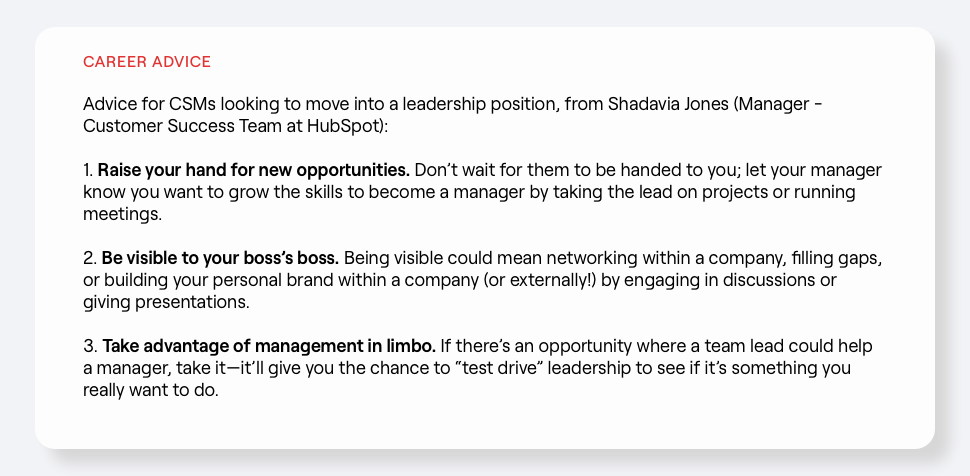
Final takeaways
We asked a group of interviewees, “what’s one thing you want the audience to take away from this piece?” Here are their responses:
“Customer Success has a unique opportunity—people can come from anywhere. I’m a case study in that: I have a Marketing and Communications background, did Consulting, all those things helped me arrive at Customer Success. What a spot to be in! When you’re hiring for CS, your pool of applicants is huge, and I would argue that it’s bigger than most roles in organizations. So don’t be foolish and miss this opportunity that Customer Success has to look different from the rest of the world. I think CS is the best industry to work in so let’s be great. We need to step up to the challenge.” — Anthony Edwards, VP of Customer Success at TiLT
“Figure out ‘why’ you want to improve your team’s diversity. Look at yourself and ask, ‘Do you honestly believe that adding people of color improves your organization, your product, and helps you get to your objectives? Or are you doing this as a feel-good?’ That’s an honest question you have to answer. And then you have to ask, ‘Do I have people in those groups that are part of my life outside of work? Have I made a conscious effort to socialize outside of the office with any of those folks?’ Have you ever gone out to eat or gone for a drink with a person of color with the intent of just getting to know them? Because meaningfully engaging in the community, like mentoring, or working with different groups, and making it part of your daily life—that will help you find those candidates, and it will help you grow as a person in the process.” — Charles Coaxum, VP Customer Experience at Kenna Security (now Cisco)
“Investing in diversity is not just about the bottom line. I don’t want to see us using that as a selling point anymore. People at companies always like to say ‘Diversity is good for business.’ Yeah, it is but diversity is for humans. We need to make sure that we’re not tying the fact that we are investing in diverse candidates or diverse pipelines or diverse perspectives, to more money. Diversity is good for humankind. — Shadavia Jones, Manager - Customer Success team at Hubspot
“Put diversity into action. Just as you work with your leadership to coordinate and execute a 3 or 5-year business plan, you have to document and aggressively pursue growth plans around diversity. The current narrative is that things will sort themselves out over time, and there will be a natural path towards equitable hiring and promotions for black people (in the private and public sectors), but that has not worked. The Customer Success space is a glaring example of this gap. My charge to Chief Customer Officers and others that have a substantial level of power and influence in your organizations is to seriously rethink it holistically, work to step away from inherent bias, and approach diversity as you do other initiatives. It’s not that you have to start creating quotas for Black people within your company, but you need to do something different and think outside the box. Just as you’re going to hire McKinsey to help solve some of your pressing strategic challenges, consider a diversity consulting group, or look to the Black people amongst your ranks to think through solutions specific to your organization.” — Ja’Rod Morris, Customer Success Advocate at Tribe Strategy
“Leaders need to know there is a vast amount of untapped talent knocking, calling, and emailing. There is no better time to start the conversation, be the change needed, and in return hire kick-ass talent that can not only change the face of the company but get the results the existing customer base is yearning for. You have to hire different, do things different, and hire people who think and look outside the box.” — Vance Gleton, Enterprise Customer Success Manager at Confluent
“I want everyone to be aware of this: getting us through the door is easy. Go beyond that, and make an effort to create the environment that we want to be in. Make an effort to create the environment we can thrive in. Black people are tired of going to work and just surviving. We would like to thrive. And we would like to do so as unbothered as you get to be. It doesn’t stop at recruiting, it doesn’t stop at hiring, it’s in your practices, it’s in your people/HR team, it’s in their attitudes, and it’s on the executives too, to take in as much information as they make their employees consume.” — Kash Young, Director of Customer Success at Articulate
“The murder of George Floyd has been a catalyst: everyone wants to do something… but they don’t know what to do. I knew in my work that my focus was never going to be dealing with police brutality even though that’s central and core to what happened to George Floyd. But where is the knee on the neck of your black and brown employees in your organization? And if you can identify that space, you can work to solve that problem, but you have to see where it fits? Where does it show up?” — Keishla Ceaser-Jones, Director of Partner Success & DEIB Leader
“Know this: these conversations are uncomfortable for everyone. That’s ok. And there’s no end—we’re not trying to ‘solve’ a one-off problem, we’re trying to make life better for everyone. So if you are a tech executive; and you’re saying, ‘My product is supposed to make life better, life easier!’ This is a way for you to put up and shut up. Your product might do those things, but what about your culture?” — Bliss Billingsley, Manager of Customer Success Mid-Market & Enterprise at LinkedIn
“Exploring the world of Diversity and Inclusion is only meaningful if acting differently than what you are used to – in your habits, in your relationships, in your biases, in your opinions – and it can be a profound and life-changing experience. However, it must be approached with reverence for the risks and certainly with some idea of the journey ahead: awareness of the point of you and education on the point of others is the first noble step in the journey. Reaching the summit of sacred “belonging” could present the challenge of a lifetime and leaders, teams and organizations must be respectful of any outcome: people could equally find themselves stuck to a fake peak. The journey is not as simple as taking a few more strolls around the block! Is it worth the effort? Absolutely.
"Systematically navigating Diversity and making it the queen (or king) of any professional and personal motion is the way we can all become better, more complete humans. For those already up there the feeling of accomplishment is profound and something that prompts them to actively diffuse it to others by osmosis.” — Marco Carrubba, EMEA Director of Cloud CS at VMware & Co-lead for the Voice of DEI at Gain Grow Retain
“Your first perception of someone isn’t always honest and true to who that person is —your judgment is based on your experiences. Be open to talking to people and getting to know them. You never know what you’re going to learn and you never know who you’re really going to connect with. Don’t let first impressions about someone be your final decision about them.” — Valerie Jones-Harvey, Sr. Director of Renewal Sales at TrustArc
“People need to be a little less concerned about their own feelings and be more focused on understanding the realities people are living instead. Leave your ego and your pride at the door and have an open mind to these conversations. Also, people look at hiring diverse populations as more of a challenge than it actually is. If you do look in the places that Black people are, and you reach out, people are really open to having these partnerships. They’re not going to get rejected every single time, they just need to start. And one more thing: I don’t know about any other department that can be run without measurements and metrics that aren’t reported on a monthly basis. Increasing diversity is not about good intentions or wishes. Measure it.” — Katrina Coakley, Manager in Customer Success at Ivanti
“People need to be prepared to do the work to address and acknowledge their privilege. And use it for good. Everything starts there. White people need to be honest with themselves and build self-reflection skills. Those things are an unstoppable force when you’re in a position of power. Be aware, come from a good place, and be actionable.” — Cairo Amani, Customer Experience Lead at Cutback Coach and Cofounder of ThriveNetwork
“It’s not enough just to shine a spotlight on the issue. It's not enough just to raise awareness of the issue. There has to be a corresponding action to make things better." — Queen Joseph, Customer Success Operations Leader
DISCLAIMER: The thoughts and opinions expressed in by individuals in this piece belong to them and do not necessarily reflect the opinions of their employers.


